#chordate
Explore tagged Tumblr posts
Text

he is staring respectfully
#prionance glauca#blue shark#meme#shitpost#fish#eukarya#animalia#chordate#chondrichthyes#elasmobranch#selachimorph#carcharhiniformes#carcharhinidae#p. glauca
2K notes
·
View notes
Text
#Paleostream 19/04/2025
here's today's #Paleostream sketches!!!
today we sketched Tullimonstrum (Tully Monster), Ornithosuchus, Xerces blue, and Ninjemys




#Paleostream#AusPalaeo#paleoart#digital art#paleontology#digital artwork#artists on tumblr#palaeoart#digital illustration#sciart#id in alt text#chordata#chordate#invertebrate#prehistoric invertebrate#invertebrate art#Tully Monster#tullimonstrum#pseudosuchian#Ornithosuchus#butterfly#recently extinct#Xerces#Xerces blue#insects#turtle#tortoise#Meiolaniidae#Ninjemys#sketch
72 notes
·
View notes
Text

Dinovember day 3! Pikaia! One of the first animals to have a spine, which means yes, you might be looking at a distant relative >:3
We all came from slug
#art#digital art#sombertide art#paleoart#paleontology#natural history#paleo#cambrian#slug#pikaia#palaeoblr#palaeontology#palaeoart#sea life#ancient life#dinovember#chordate#chordata#what a funky little guy#this one took me the least time so far#getting better at this style
321 notes
·
View notes
Text
I want to be a geo witch. A paleo-necromancer.
I want to listen to the rocks on the side of the road and hear about drama from 3.2 Billion years ago. I want to wear a hat with a ridiculously wide brim. I want to show the ghost of Jurassic ginkgos and Permian Cycads how tall and proud their ancestors are. I want to raise the old ones and have a consensual battle with my Kollikodon against someone else's up little critcher. I want to give a velociraptor a pat on my lap and tell them how wonderful they are with little kisses. It's bullshit and unfair.
#paleoblr#witchblr#earth witch#geo witch#paleonecromancer#paleo necromancy#necromancy#palaeontology#paleontology#magic#witch#deep time#ginkgo#cycade#kollikodon#monotreme#mammal#my boi#velociraptor#dromeosaur#raptor#maniraptoran#theropod#dinosaur#animal#animalia#metazoa#vertebrate#chordate#earth mage
37 notes
·
View notes
Text
The modern world is nice, but sometimes you just get the urge to go primitive. Because I'm a complete wimp who would die within a day of giving up the internet, I'm going to deal with that urge by talking about primitive animals. It's Wet Beast Wednesday and I'm talking about lancelets.

(image: a lancelet. Not much to look at, are they?)
Lancelets, or amphioxi, are highly basal (close to the ancestral form) chordates that are vaguely similar to fish, but are vastly more primitive. They have all the characteristics of chordates, the key one being a notochord, a flexible rodlike structure that goes down the body. The majority of chordates that are still alive are vertebrates, who have incorporated the notochord into the spinal column. The other groups of surviving chordates are the tunicates (who I'll get to eventually) and the lancelets. Because lancelets are so primitive, they are used at model organisms representing an early stage of vertebrate evolution. It was originally thought that lancelets are remnants of an early lineage that eventually evolved into vertebrates. Genetic studies later showed that tunicates are actually more closely related to modern vertebrates than lancelets. They are still used as a model organism as they are a fantastic representation of early chordates. The similarity of lancelets to the 530 million year old Pikaia gracilens, one of the earliest known chordates, is one of the reasons they are such a useful model organism.

(image: a diagram of lancelet anatomy by Wikipedia user Systematicist)
Lancelets can be found all over the world, living in temperate to tropical shallow seas. The only known exception is Asymmetron inferum, which has been found around whale falls at 225 m (738 ft) deep. They are small animals, reaching around 8 cm at their largest. An amphioxus looks pretty worm-like, with a simple mouth at one end and a pointed tail at the other. The name amphioxus means "both (ends) pointed" which is a pretty appropriate description. The mouth is lined with tentacle-like threads called oral cilli, which are used for feeding. Lancelets are filter-feeders that use the cirri to filter plankton, microbes, and organic detritus. Water and food pass into the pharynx (back of the mouth), which is line with gill slits. This is where it gets weird. The gill slits aren't used for respiration, but for feeding. Mucus gets pushed through the gill slits by cilia, trapping the food and moving it deeper into the digestive tract. Not only to lancelets not use their gill slits to respirate, they actually don't have a respiratory system at all. Instead, they just absorb dissolved oxygen through their thin and simple layer of skin. Their circulatory system doesn't move oxygen around either as there is no heart or hemoglobin present. For what it's worth, they don't have a proper live either. When you look at a lancelet's anatomy, you can see similarities to fish anatomy, just much more primitive and with some parts missing.
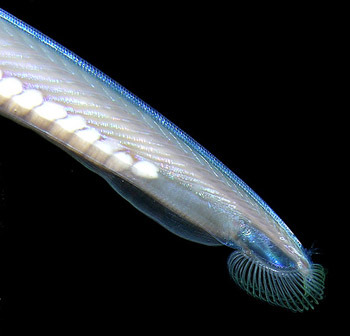
(image: the head of a lancelet, with mouth and cilli visible)
Lancelets have 4 different systems used for vision. Two, the Joseph cells and Hesse organs, are simple photoreceptors that are on the notochord and detect light along the back of the animal. Imagine having a bunch of very simple yes on your spinal cord that can see through your skin. There is also a simple photoreceptor called the lamellar body (which confusingly is also the name of a type of lipid) and a single simple eye on the head. Speaking of light, lancelets are florescent, producing green light when exposed to blue to ultraviolet light. In all species, the proteins responsible for this are found around the cilii and eye, but some species also have them in the gonads and tail. The purpose for this florescence isn't exactly known, but a common hypothesis is that it helps attract plankton toward their mouths.
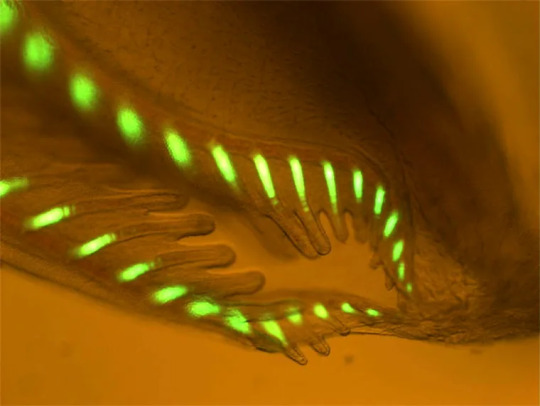
(image: an extreme close-up of a lancelet's cilli fluorescing)
Lancelets have seasonal reproduction cycles that occur in summer. Females release their eggs first, followed my males releasing sperm to fertilize them. Depending on species, spawning can either occur at specific times, or gradually throughout breeding season. Development occurs in several stages. In the frist stage, they live in the substrate, but they will quickly move into the water column to become swimmers. These swimming larvae practice diel vertical migration, traveling to the surface at night and returning to the seafloor in the day. While larvae can swim, they are still subject to the current and can be carried long distances. Adults retain their ability to swim, which is done by wriggling like an eel and in some cases, spinning around in a spiral fashion while moving forward. Unlike the larvae, adults spend most of their time buried in the substrate with only their heads exposed. They typically only emerge when mating or if disturbed.
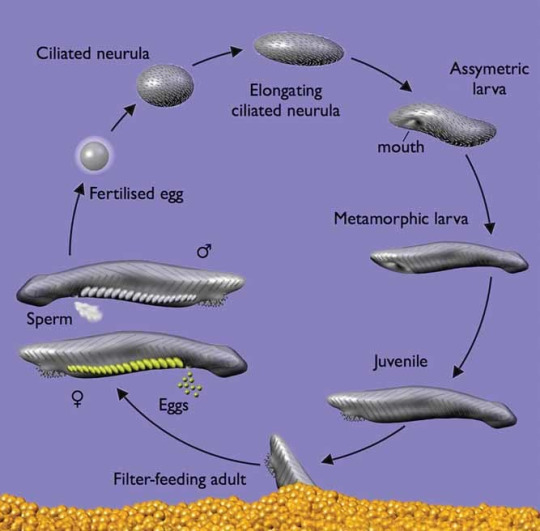
(image: a diagram of the lancelet life cycle. source)
Because of their use as model organisms, humans have developed methods to keep and breed lancelets in captivity. The majority of research has been done on Branchiostoma lanceolatum, but several other species have been studied. Multiple species are endangered due to pollution and global warming. Several species are edible and can either be eaten whole or used as a food additive. In spring, when their gonads begin to develop for breeding season, they develop a bad flavor.
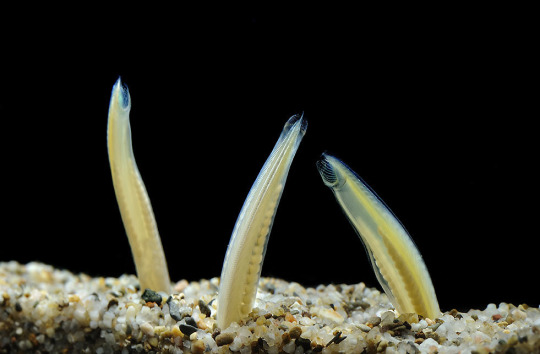
Mom: "we have garden eels at home". Garden eels at home:
(image: three lancelets sticking their heads out of the sediment)
#wet beast wednesday#weird-ass tube beast#lancelet#amphioxus#chordate#chordata#marine biology#biology#ecology#zoology#animal facts#evolutionary biology
250 notes
·
View notes
Text

#IFTTT#Flickr#blackbilledsicklebill#drepanornisalbertisi#blackbilled#sicklebill#drepanornis#albertisi#animalia#animal#chordata#chordate#vertebrata#vertebrates#aves#bird#passeriformes#perching#paradisaeidae#birdsofparadise#birding#arfakmountains#westpapua#indonesia#wild#wildlife#nature#canon#2024#jonodashper
12 notes
·
View notes
Text
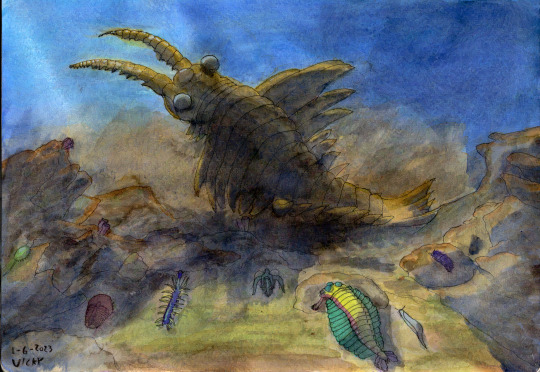
Mighty Anomalocaris stirs, spreading dust and terror throughout the Cambrian sea. Opabinia, Hallucigenia, Pikaia, Canadia, Burgessia, Marella, and Elrathia can only hope the rocks and ridges they cover behind will hide them.
#cambrian#anomalocaris#Opabinia#Hallucigenia#Pikaia#Canadia#Burgessia#Marella#Elrathia#hazelia#radiodont#arthropod#paleoart#my art#palaeoblr#lobopod#trilobite#chordate#sponge#cambrian explosion
209 notes
·
View notes
Note
thank you so much!!!!!!! I just looked up "what the sneef I'm snorfin here animal" and your tags from a year ago informed me that it was an elephant shrew!!! those are such delightful creatures!!!! you are responsible for bringing so much joy into my life!!!!!!! Thank you thank you thank you!!!!! I love their silly little snouts!!!!
See, it's moments like this that are the real reason why I tag everything!
And yeah elephant shrews rule.
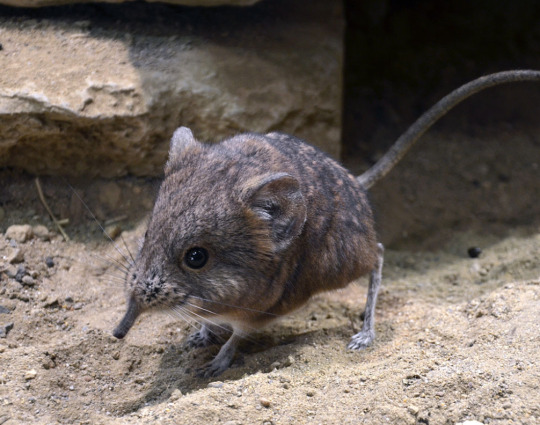
Look at this little freak. It owns.
Elephant shrews (aka sengis) are related to aardvarks, manatees, and of course, elephants. (They aren't especially closely related to true shrews though.)
They belong to the taxonomic clade Afrotheria, which are basically a bunch of mammals that evolved in Africa in the Cretaceous period when it wasn't connected to Eurasia, so they diversified and spread out into lots of different environmental niches.
Presumably a lot of these Afrotherians died out as a result of competition with animals in the same niches from Eurasia when the continents came together, but thankfully we are still left with megafaunal elephants, big ol' sea cows, tiny insectivorous elephant shrews, semi-aquatic giant elephant shrews (potamogalidae), golden moles, and probably my personal favorite: tenrecs which are funny little hedgehoggy mouse-lookin' things that are basically only found in Madagascar.
Like, look at this picture of a lowland streaked tenrec.

It looks like an electric type Pokemon dude.
images yoinked from wikipedia (because I was too lazy to find more interesting or obscure pictures lmao): 1 round-eared elephant shrew 2 lowland streaked tenrec
#ask#Anonymous#elephant shrew#jmc#tags#tagging#animal#chordate#mammal#afrotherian#tenrec#lowland streaked tenrec#sengi#what the sneef? I'm snorfin' here!
21 notes
·
View notes
Text
Most popular animal tournament
#tumblr polls#poll#random poll#i love polls#poll time#my polls#polls#daily polls#poll for funsies#Animals#tumblr poll#hyperspecific poll#poll for everyone#poll for you#poll fun#poll tournament#poll game#polladay#polls polls polls#polls are fun#random polls#silly poll#tournament poll#poll blog#tournament polls#animal#chordate#chordates#fish#frogs
12 notes
·
View notes
Text

Rock doves (Columba livia), along with an American crow (Corvus brachyrhynchos), a European starling (Sturnus vulgaris), and way in the back, a house sparrow (Passer domesticus); March 2023
Washington DC
City bird extravaganza!
#2023#march#chordate#avian#columbiformes#columbidae#columba livia#passeriformes#corvidae#corvus brachyrhynchos#sturnidae#sturnus vulgaris#passeridae#passer domesticus
10 notes
·
View notes
Text

Pikaia, an early chordate.
5 notes
·
View notes
Text
[id: a photo of a ptarmigan peeking out through the snow. Only part of its head is visible. end id]
So I was watching a video on ptarmigans and it was mentioned that they dig burrows in the snow for shelter and protection. Which, cool! Burrowing bird! Then they showed this picture and

It's perfect
#described#it's a willow ptarmigan. so probably from Alaska or the Canadian Territories. You can tell because it doesn't have the red eyebrow#it pisses me off that european rock ptarmigan are routinely misidentified on tumblr as willow ptarmigan#I've actually seen a grouse jump out of snow before. It wasn't a ptarmigan because it was still brown in mid-winter in Yellowknife#terrestrial biology#chordate#aves
32K notes
·
View notes
Text
Rectangl
(alt:)
vetulicola rectangulata swimming, it's an early stem chordate, somewhat tadpole-like motion, the 'head' in rectangulata has a rectangle shape in the front and more oval at the back, there's a line dividing the top and bottom half of the 'head' which contains five round openings identified as gill slits. It has a pointy Shark like dorsal fin at the top followed by a flat segmented tadpole like tail sticking out after the top dorsal fin)
#paleo art#paleoart#palaeoblr#vetulicolia#vetulicola#vetulicola rectangulata#cambrian period#paleontology#chordates
1K notes
·
View notes
Text
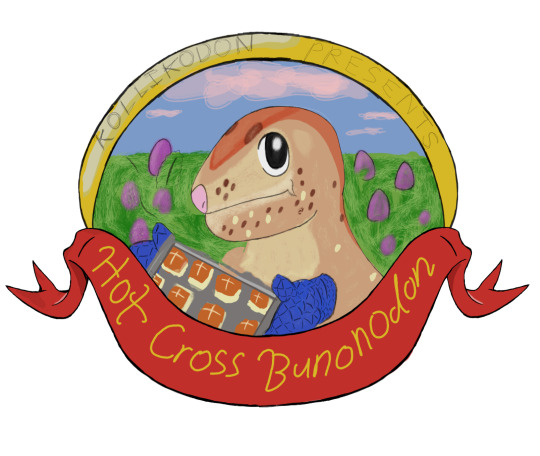
Kollikodon Presents: Hot Cross Bunodon WIP GAHHHH!! So close to Easter! I juuuuust missed it! Maybe I can make it presentable tomorrow? maybe...
#my art#paleoart#hot cross buns#WIP#easter#Kollikodon#stem monotreme#mammal#animal#chordata#chordate#paleoblr#bread rolls#hotcrossbunodon#bunodon#teeth#mesozoic#mesozoic mammals#bread#australian prehistory#lightning ridge#did she lay those eggs in the background? Whooooo knoooows???#prehistoric mammals#palaeontology#paleontology#digital art#eggs#easter egg
9 notes
·
View notes
Text
Round 1 - Phylum Chordata
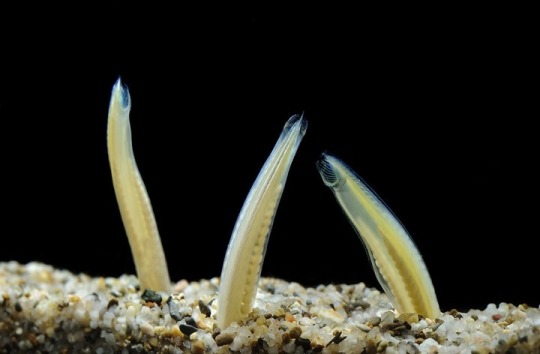


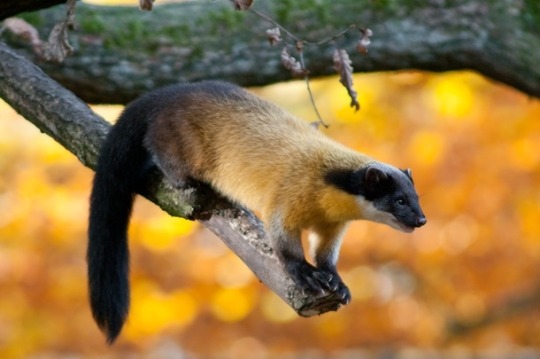
(Sources - 1, 2, 3, 4)
Chordata is a phylum consisting of bilaterial animals that have, at at least some point in their development, a notochord and a dorsal nerve chord. It consists of the Cephalochordates (lancelets), Tunicates (sea squirts, salps, and larvaceans), and Vertebrates.
Vertebrates replace their notochord with a spine in early development, while tunicates only retain their notochord and dorsal nerve chord during their larval stage. Vertebrates and tunicates are more closely related to each other than they are to lancelets (first image), which are fish-shaped filter-feeders. They typically inhabit the sea floor, burrowing the bottom halves of their bodies into soft substrate. They have gill slits, but these are used for feeding on plankton rather than respiration. They have light-sensing organs, and one frontal eye. They do not have hearts or brains. They have two sexes, though hermaphroditism has been observed, as well as at least one instance of a lab-raised female transforming into a male. They breed by releasing eggs and sperm into the water synchronously. Larvae are asymmetrical, with the mouth and anus on the left side, and the gill slits on the right side.
Most tunicates are also filter-feeders, ranging from the sessile, sponge-like sea quirts (second image) to the planktonic salps. All tunicates start life as free-swimming, tadpole-like larvae with rudimentary brains and light sensors, before they metamorphize into their adult forms. Meanwhile, the larvaceans retain tadpole-like shapes and active swimming all their lives. Salps move by contracting, similarly to jellyfish, straining phytoplankton from the water. They have a complex life cycle, in which one generation of solitary individuals reproduces asexually by producing a chain of tens to hundreds of individuals, which are released from the parent at a small size. The next generation consists of a colony of salps (called blastozooids) remaining attached together while swimming, feeding, and growing. This generation reproduces sexually, first maturing as females and later transforming into males. Older chains of male blastozooids will fertilize the eggs of younger female chains. Growing embryos are called oozooids, and eventually detach from their parent blastozoids, to feed and grow as the next solitary, asexual generation. Meanwhile, some species of sea squirt live as solitary individuals, while others replicate by budding and become colonies of zooids. They are filter feeders with two tubular openings, called siphons, through which they draw in and expel water.
The most simple vertebrates are hagfish, which have a skull but no vertebral column. They are marine predators and scavengers who can defend themselves against larger predators by releasing copious amounts of slime from mucous glands in their skin.
Lampreys have an ambiguous position in the vertebrate tree of life, bearing a complete braincase and rudimentary vertebrae. They spend the majority of their life as filter-feeders. A small handful of species are known to be carnivorous as adults, boring into other fish to consume flesh and/or blood.
Chondrichthyes (“cartilaginous fish”) have skeletons composed mainly of cartilage. They breath through gills but lack opercula (gill coverings). They have internal fertilization and some species lay eggs while others give live birth. Chondrichthyans have tooth-like scales called dermal denticles or placoid scales. These usually provide protection, and in most cases, streamlining. Today, chondrichthyans are represented by sharks, rays, skates, sawfish, and chimaeras. All species are carnivores, though at least one species is omnivorous.
The majority of chordate species are Actinopterygians (“Ray-finned Fishes”). They are so called because of their lightly built fins made of skin webbings supported by thin bony spines. They are the most abundant free-swimming aquatic animals and can be found almost anywhere there is water. They come in a vast majority of sizes, shapes, colors, and behaviors, from the 8 mm (0.3 in) long Paedocypris to the 11 m (36 ft) long Giant Oarfish (Regalecus glesne). In most actinopterygians, males and females exist and reproduce through external fertilization. However, some species utilize sequential hermaphroditism, in which they start life as females and convert to males at some point. In a few species, they start life as males and convert to females. Some species give live birth, and some species self-fertilise. Actinopterygians have feeding strategies ranging from predatory to grazing to filter-feeding.
And lastly, the Sarcopterygians (“Lobe-finned Fishes”), named for the prominent muscular limb buds (lobes) within their fins. They are represented by the coelacanths, lungfish, and tetrapods. The vast majority of the rest of chordate species are tetrapods, a terrestrial clade of sarcopterygians who evolved air-breathing using lungs. They are highly diverse, with a large variety of forms, biological strategies, and ecological roles. Along with arthropods, they are the only other group of animals to have adapted to life in dry environments, and the majority of them live on land.
Chordata is one of the largest phyla of animals when it comes to species and is also one of the oldest phyla, known from as early as the Cambrian explosion.

Propaganda under the cut:
Lancelets naturally express green fluorescent proteins. They may use this green fluorescence to attract plankton towards their mouths.
Mentioned briefly above, the Bonnethead Shark (Sphyrna tiburo), a small species of hammerhead, is the only shark known to be omnivorous. While it feeds on crustaceans, molluscs, and small fish, it also ingests large amounts of seagrass, which has been found to make up around 62% of gut content mass.
The Mangrove Rivulus (Kryptolebias marmoratus), a species of killifish, mostly breeds by self-fertilization and can survive for about two months on land. Males are rare, and can only hatch from eggs kept below 19 °C (66 °F).
The largest chordate is the Blue Whale (Balaenoptera musculus), which can reach a maximum confirmed length of 29.9 m (98 ft) and weigh up to 196 long tons; 219 short tons). While it’s not the longest, it is the largest animal known to have ever existed.
At least one of your favorite animals is probably in this phylum. Most of the animals people keep as pets are in this phylum. We are in this phylum.
I am tired, and there is no way I can write enough propaganda for this poll, so I trust you can supply your own.
#round 1#animal polls#i was lookin for a gif and I just searched Bird and Gritty was in there for some reason#and I had to be like I Mean??#I GUESS??!?!#he’s a chordate???!??#anyway WE DID IT GUYS WE MADE IT THROUGH ALL THE PHYLA#chordata
166 notes
·
View notes
Text
Mordecai does this in Regular Show.
American Woodcock demonstrates "distal rhynchokinesis," the ability to flex the end of its bill. This allows it to grab earthworms it encounters when probing in soil. Other shorebirds, including Dunlins & Sanderlings, can bend their bills in this way. 😃
18K notes
·
View notes